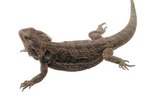
Long-tailed lizards are underappreciated as pets. They lack the size of monitor lizards, the personality of bearded dragons and the bright colors of chameleons. Nevertheless, they exhibit interesting natural behaviors when kept in well-designed enclosures. Using their tails to help them balance on thin branches and twigs, long-tailed lizards are remarkably quick and agile predators. To keep your lizard healthy and happy, provide him with a spacious enclosure with numerous branches and plants for him to perch on and hide in.
Enclosure
Long-tailed lizards (Takydromus sp.) require clean, secure, spacious cages that allow them to exhibit natural behaviors and thrive. Glass aquariums fitted with screen tops are popular options; but front opening, plastic cages are acceptable as well and in some cases preferred. The cage should offer at least 2 square feet of floor space and at least 12 to 18 inches of height.
Decorations and Substrate
You can use a number of substrates to maintain long-tailed lizards, including cypress mulch or orchid bark, as well as utilitarian substrates such as newspaper or paper towels. Change paper towels or newspaper at least twice per week; spot-clean particulate substrates daily, and completely change the mulch periodically. It is helpful to smell your lizard’s cage frequently, and follow your nose: If the cage smells acidic, sour or dirty, clean the cage and change the substrate. Long-tailed lizards require numerous branches, vines or plant stems to use as perches and leaves to use for hiding spots. Artificial plants are the easiest option, but live, nontoxic plants are more aesthetically pleasing.
Heating and Lighting
You must provide your long-tailed lizard a thermal gradient so he can manage his body temperature. Do this by placing a heat lamp at one end of the enclosure over several perches of varying height. Provide wattage to reach the desired temperatures; the warmest perches should be about 90 degrees Fahrenheit; perches farther from the basking lamp should have lower temperatures with increasing distance. The coolest parts of the cage should be in the mid- to high 70s. In addition to a basking lamp, long-tailed lizards require full-spectrum lights for proper health; use full-spectrum fluorescent bulbs that produce visible light as well as light in the UVA and UVB portion of the spectrum. Leave the basking and full-spectrum lights on for 12 hours per day, allowing the cage to be dark and drop in temperature.
Food and Water
Long-tailed lizards are insectivores who prey on small insects and other invertebrates. Feed your pet every day -- include a variety of insects including crickets, mealworms and roaches. Be sure to offer food of the appropriate size; feeder insects should be no longer than your lizard’s head is wide. Offer feeder insects a variety of fresh vegetables before giving them to your lizard. Dust feeder insects with a vitamin-and-mineral powder twice per week. Mist the cage walls and plants in your lizard’s cage every morning to provide drinking water. Though he may not use it, it is good practice to provide your lizard a water dish. Your lizard may bathe or defecate in the water, and it is imperative that you keep the water clean at all times.
References
Resources
Photo Credits
-
Thinkstock/Comstock/Getty Images




